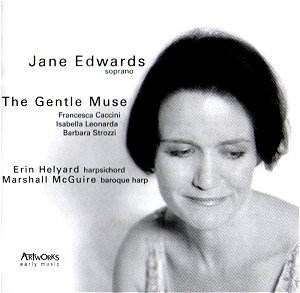There were female composers in the medieval and early
renaissance periods. Take, for example, the Condesa de Provenza Garsenda
and the Condesa di Dia in the 12th and 13th Centuries.
However it was not until the 17th Century that women start
to emerge as true creative artists of distinction not only in music
but in poetry and in the theatre. Also they emerged as fine and well-paid
performers. The three ladies focused on here are not only competent
composers but at times they are each touched by genius and originality.
Australian soprano, Jane Edwards, already has two other
discs on the Artworks label to her credit. Well done to Ms Edwards and
to harpsichordist Erin Helyard and to Marshall McGuire for some fine
instrumental work in accompanying such a sensitive singer for presenting
this programme so convincingly.
There is no doubt that Barbara Strozzi stands out in
any company. Over forty-five minutes of this CD is devoted to her compositions.
She is surely the first outstanding female composer. She came from a
privileged and wealthy background of artists and artisans. Her poet-father
wrote opera libretti for Monteverdi and Cavalli. Barbara was permitted
to perform her own work and she was highly praised. There are over 100
compositions and several have been recorded before not least by Glenda
Simpson on Hyperion (CDA 66303) with the Camerata of London.
Barbara Strozzi is a dramatic composer as exemplified
in the remarkable ‘Lamento’ with its falling augmented second and impassioned
lines. At over ten minutes one feels that Monteverdi himself could not
have improved on it. This one work alone is worth the price of this
disc.
The CD does not however get off to a good start I feel,
with a lack lustre performance of ‘Amor dormiglione’. To appreciate
how this should be done one should listen to the vital and lively performance
of Glenda Simpson. The text "Cupid ….. Up, up wake up now"
needs urgency not a lazy mellifluity. However after that, Jane Edwards
never puts a foot wrong, in what proves to be a varied anthology of
cantatas and songs. If Strozzi’s approach has a debt to the Monteverdi
of ‘Poppea’ and her own teacher Cavalli, Francesca Caccini is more in
debt to her father Giulio and his so-called ‘secundo practica’ style
of recitative and figured bass. That is not to say that she does not
have a character of her own. She produced an opera in 1625 ‘La liberazione
di Ruggiero’ and it is therefore the earliest known opera by a female
composer. Her collection ‘Il primo Libro della musiche’ came out in
1618. There is no noticeable difference between her secular works and
the sacred for example, ‘Jesu Corona virginum’. Each is strophic with
ornamentation and brief instrumental sections.
Isabella Leonarda was prolific herself. She was a nun
and later a mother superior at the convent of ‘Santa Orsolo’ in Novara.
She wrote in all genres including 96 motets. Apparently she worked when
the convent rested so as not to interfere with her other duties. The
two short cantatas here are both to sacred texts.
It is entirely possible that all three ladies wrote
their own texts. Strozzi came from a literary background, Caccini came
from an entirely musical and intellectual family well versed in opera
and Leonarda may not have had access to modern texts in her quiet convent
so therefore needed to write her own.
To give you a taste of this CD I will look briefly
at Leonarda’s ‘Vanne lunge’ (Be off with you deceiving world). This
consists of eight four-line strophes, which develop the theme of devotion
to Christ and rejection of the world, which brings contentment and joy.
Here Jane Edwards is at her best. This starts with a generally elegant
approach to the wide-ranging and delightfully flowing melody of verse
1. This is in compound time with its first line repeated at the end.
Verse 2 is slower and more expressive with a few instrumental bars to
end.
Verse 3 (My whole being feels comforted) is akin in
speed to verse 1 but now in duple time and more ornamented. A gentle
approach is adopted to Verse 4 in a flowing 6/8 time. Verse 5 is in
a recitativic style. Verse 6 is back in 6/8 time but stronger than before.
Verse 7 is marked Presto and is quite virtuosic. Again, and throughout,
word repetition is important. Verse 8 (For you my Jesus victories are
inevitable) is again in a strong 6/8 time. Each verse is characterised
by the composer in a simple but clear architecture and is likewise followed
through by the performers.
The booklet notes are excellent with a colour reproduction
of a portrait of Barbara Strozzi. The texts are nicely translated. The
recording is mostly successful and the acoustic is helpful. However
at times I find the harp is unnaturally forward of the voice, which
sometimes gives the impression that she is standing behind the
instrumentalists. That said, Edwards is never obscured and the balance
is always natural. [see note below]
This generously filled disc is a fascinating example
of rare repertoire that should be explored by anyone interested in the
early baroque.
Gary Higginson
GH writes that "at times I find
the harp is unnaturally forward of the voice, which can seem as if she
is standing behind the instrumentalists. Although Edwards is never obscured
the balance is unnatural."
The balance with the harp (and harpsichord)
in front of the voice is not at all 'unnatural': This is exactly how
these performers were positioned in the recording venue and, indeed,
how they position themselves when performing in concert. This sort of
set up enables much greater ensemble precision as the soloist can clearly
see the hands of
both instrumentalists. Of course some conventions dictate that a singer
should be heard in front of accompanying instruments but disrupting
the wishes of performers in this way could have a negative influence
on performance quality.
Andrew McKeich
Artworks
AVAILABILITY
http://artworksmusic.com


